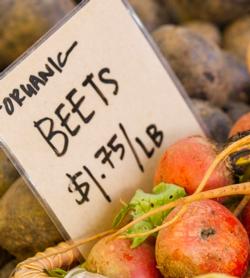Marketing

- What should I grow? How much of it should I grow and harvest at a given time?
- Who is my ideal customer? Where can I most effectively connect with that customer base?
- How will I appeal to these customers and entice them to buy my products?
- How can I estimate how much they will buy?
- How can I develop the flexibility to change my marketing strategy if my current plan isn't giving me the results I desire?
Marketing Basics

|
Many growers, especially new ones, are inclined to start production without giving a second thought to the business of marketing. Good marketing is an absolute must for a successful agricultural enterprise. Some would even argue that it ranks higher in importance than production itself, especially for farmers planning to diversify. After all, what good is a product if one cannot sell it consistently for a profit? UCCE Placer/Nevada and UC Resources |

- To Market, To Market (Rutgers Cooperative Extension)
- Direct Marketing (ATTRA)
- Farmers Markets: Marketing and Business Guide (ATTRA)
- Growing for Market: News, Advice and Resources for Market Farmers (website)
- Growing for Market: Special Report on Selling at Farmer's Markets
- Marketing Strategies for Farmers and Ranchers (SARE)
Market Analysis

These tools will help you hone your product and your marketing tactics and reduce the time you spend on ineffective strategies:
- A Marketing Primer for Start-up Business - Agricultural Marketing Resource Center
- ATTRA - Adding Value to Farm Products: An Overview
- ATTRA - Community Supported Agriculture
- ATTRA - Direct Marketing
- ATTRA - Entertainment Farming and Agri-Tourism
- ATTRA - Farmers' Markets
- ATTRA - Market Gardening: A Start-up Guide
- ATTRA - Selling to Restaurants
- Cal Poly San Luis Obispo - Developing Your Market Plan
- Cornell - Knowing Your Market: The Most Challening Part of a Business Plan
- Cornell - Travel the Road to Success with a Marketing Plan
- Iowa State U - Determining Prices for CSA Share Boxes
- Purdue Extension - Marketing's Four P's: First Steps for New Entrepreneurs
- South Dakota State University - Market Plan
Assessing and Managing Market Risk
Sources of marketing risk include:
- price risk due to increases in supply, changed demand, market trends, or improper pricing of products;
- loss of market access due to the relocation or closing of an existing market or processing plant or lack of understanding of the requirements of various market options;
- loss of marketing power due to lack of knowledge about potential marketing opportunities and options;
- improper or lax recordkeeping resulting in having too much or not enough product week-over-week at a given market.
- Creating a marketing plan, a constantly evolving document that relates directly to your farm business plan
- Maintaining your knowledge of markets for your products via regular market analysis and customer research
- Pricing correctly for your markets and your efforts
- Effective record-keeping
- Exploring alternative marketing strategies, alternative marketing organizations, and value-added ventures
Other Marketing Options

An example of grower use of these tools is Dinner Bell Farm in Chicago Park. In addition to a website, they use YouTube videos, Twitter, Facebook, and a Flickr photo gallery.
